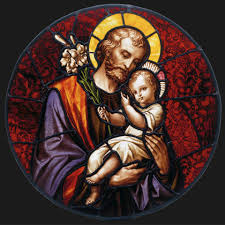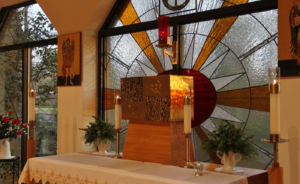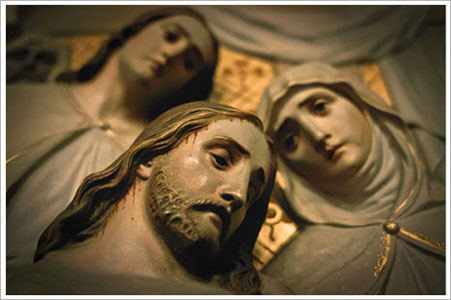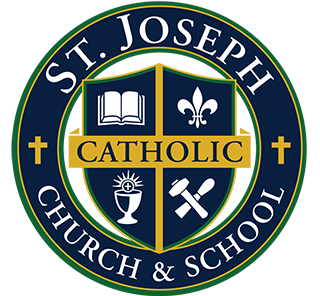About Our Parish
 Building Faith & Knowledge for Life!
Building Faith & Knowledge for Life!
We, the people of God at St. Joseph Catholic Church & School, acknowledge the mission of Holy Mother Church as seeking the salvation of souls by making disciples of all nations—teaching them all that Jesus Christ has commanded (Mt. 28:19-20).
Through the overarching mission of Catholic education, we strive to promote the proper understanding of Catholic faith & values in union with our Bishop, Most Reverend Jacques Fabre-Jeune, faithful to the Holy Father, Pope Francis, and true to the Magisterium of the Catholic Church.
We respond to God’s call to know Him, love Him, and serve Him through Prayer & Worship, Formation & Evangelization, Community Building, Community Outreach, and Stewardship & Communication by Building Faith & Knowledge for Life within our parish and throughout our local community.
- Through Prayer & Worship, we nurture in our hearts and minds the seeds of faith given to us by the grace of God.
- Through Formation & Evangelization, we sow God’s love & mercy by teaching others about Him, who is Love.
- Through Community Building, we cultivate ourselves in order to bear the fruit of God’s grace & blessing in our lives.
- Through Community Outreach, we sow the seeds of peace & hope within our culture.
- Through Stewardship & Communication, we sharpen ourselves & our brethren to reap the harvest from that which has been sown.
In all things, our focus is our Lord, Jesus Christ. We thrive on His presence in the Blessed Sacrament. We pray daily for vocations and encourage an atmosphere for all to say “yes” to God’s call to be the light of the world (Mt. 5: 14). Empowered by Baptism and sealed with the Holy Spirit, we instill and exemplify Christian Leadership throughout our parish with our time, talent, and treasure.
At St. Joseph Catholic Church & School, we are Building Faith & Knowledge for Life!
 The heart of a parish is the Eucharist, but the parish family is the body that makes it a unique and vibrant community with an exciting parish life. Our parish offers a variety of ways to be part of that communal family in addition to the celebration of the sacraments.
The heart of a parish is the Eucharist, but the parish family is the body that makes it a unique and vibrant community with an exciting parish life. Our parish offers a variety of ways to be part of that communal family in addition to the celebration of the sacraments.
Faith formation is a vital element of the Catholic life as we grow in knowledge and understanding of our faith in Jesus Christ and the Church he gave us. A deeper understanding can lead to a more intimate relationship with the Father, Son, and Holy Spirit, and through the Trinity to the Church and our family, friends, neighbors, parish, and community. Such faith formation is not just for children, but for all of us as we grow as Catholics. Our parish has many opportunities for faith formation that we encourage you to explore.
Another way to participate in our parish life is the various parish ministries, including liturgical ministries, such as choir member, lector, altar server, and Extraordinary Minister of the Eucharist; social justice ministries, such as visiting the homebound, serving the poor, volunteering at food pantries and the Birthright of Clemson; and others, such as youth ministry, men’s and women’s group, and the annual Gala for our Parish School, to name just a few. God calls us to use our gifts and talents to glorify Him and make life better for other people. Please prayerfully consider these opportunities for getting involved in ministry. And if you have an idea for a new parish ministry, please contact us.
With so many ways to be part of parish life, you’ll want to stay informed by regularly reading the weekly bulletin, just in case you’ve misplaced the one you received at Mass. You’ll also want to check the parish calendar for a list of events and mass schedules.
Our parish has a rich history in our town, being founded by people who trusted in the Lord and gathered together under the leadership of our bishop. Who we are today is based on who we were yesterday. Find out more about our spiritual forefathers as you read the history of our parish.
We hope you’ll also enjoy viewing photos of our parish, including some of the many enjoyable events and programs we’ve had over the years.
 Our Catholic faith comprises what we believe and how we live that belief. For 2,000 years, this Catholic faith has been handed down from one generation to next, starting with Jesus Christ passing the faith to the Twelve Apostles. In our own lives, we may receive that faith from our parents, from friends, or even a stranger we meet.
Our Catholic faith comprises what we believe and how we live that belief. For 2,000 years, this Catholic faith has been handed down from one generation to next, starting with Jesus Christ passing the faith to the Twelve Apostles. In our own lives, we may receive that faith from our parents, from friends, or even a stranger we meet.
Living as a Catholic includes many wonderful beliefs, practices, and devotions; too many to catalog here. But we hope to provide you with a brief overview of what we believe and how we live that belief.
We hope this resource will be valuable to both interested non-Catholics as well as to those already Catholic who might be looking to deepen the practice of their faith.
If you want to know more about discovering our Catholic faith as a newcomer to the Church or re-discovering the Catholic faith you received at baptism, you may want to start by exploring our Newcomers section.
To learn about what we believe as Catholics, you will want to start with What Do Catholics Believe? But if you want to learn more specifically about the seven sacraments, visit the Sacraments area of our site.
Our Parish History
 1791
1791
Recently discovered information reveals that the French Catholic family — Peter LaBoon (Pierre LaBon)–resided in the Brushy Creek township in the old Pendleton District (now Anderson County)around 1791. The family remained Catholic until about 1825 when the children married into Protestant families as there was no church nor Catholic priests in the area. Many of the members of the LaBoon family are buried in the Fairview Methodist Church Cemetery.
A Cemetery riding priest from Montreal rode annually to New Orleans and sought out Catholic families on the way. In the winter of 1792 – 1793, this priest came to the home of Peter LaBoon. The priest made annual visits to Anderson County until 1799.
1850
For the next fifty years, Catholicism lay dormant in Anderson. In 1850 the Reverend Jeremiah O’Connell began visiting Anderson twice a year. Father O’Connell was a priest with the Columbia, South Carolina, Missions. He records in his book Catholicity in the Carolinas and Georgia, published in 1879 that the families of Timothy Whelan and William and James Shanahan were his host while making his semi-annual visits.
1854
The next recorded Catholic families to live in this area were operatives on the Blue Ridge Railroad started around 1850. By 1854 the railroad was as far as Walhalla and many Irish Catholic laborers were brought from New York and Pennsylvania to dig the tunnel through Stumphouse Mountain. A large settlement known as Tunnel Hill grew up with about 500 residents. A frame church–St. Patrick’s –and rectory were built. Father O’Connell and two other priests– Father Lawrence O’Connell and Father Joseph– made this their headquarters for all upstate missions beginning with Anderson.
1868
Two families connected with the Blue Ridge Railroad project became permanent residents of Anderson–Captain John McGrath and Mr. M. D. Kennedy. these men visited Columbia, Charleston, and Savannah collecting funds for the purpose of purchasing land and building a church. civil records show that a lot at the corner of North McDuffie and Earle Streets was deeded to Rt. Reverend P. N. Lynch, Bishop of Charleston, on December 15, 1868.
1881
Between 1868 and 1881, the church was built and the parish family grew when several Polish families moved into the area.
St. Joseph’s first permanent church was dedicated on May 10, 1881, by Bishop Lynch. The Anderson Intelligence, in an article on the dedication, quoted Bishop Lynch congratulating the little band of faithful in Anderson who had built this temple of worship. A small cemetery was located behind a church. Mrs. Bridget Kennedy was the first to be buried there.
1900
In 1900 Madame Rose Lummis, a nun of the Sacred Heart, from Simcoe, Ontario, Canada, arrived with her companion Miss Gleason to open a school in Anderson. Madame Lummis came to Anderson due to health problems and before her school could be started she succumbed to pneumonia. She is buried in Silver Brook Cemetery. Sr. Lummis is the subject of a Vatican investigation for Beatification.
1910
The Parish grew again in the early 1900’s due to an influx of skilled Bohemian weavers employed by the Anderson Mill. By 1910 the original church was too small. Father Andrew Gwynn of Greenville solicited donations from his Northern friends, parishioners, and area non-Catholics for the purpose of enlarging and renovating the McDuffie Street church. Bishop Northrup rededicated the church on October 10, 1910.
1919
In 1919 Father Thomas Macklin was appointed the first resident pastor in Anderson, succeeding Father Gwynn who served the parish for nine years. The Anderson church was part of a three-church mission: Sacred Heart in Abbeville, Our Lady of Lourdes in Greenwood, and St. Joseph’s in Anderson.
1922
Father Timothy McGrath was appointed pastor in 1922. He stayed in Anderson until 1925 when Father E. F. Sweeney came as pastor until the parish was returned to the Greenville Mission. Anderson was without a resident pastor until 1929.
1929
In 1929 Father McGrath returned to St. Joseph’s and built a rectory adjacent to the church on McDuffie Street.
1930
In 1930 Father Henry Speisman was appointed pastor. He was the fifth pastor of St. Joseph’s and was assisted by Father Charles Baum until 1940.
1949
From 1949 to 1952, St. Joseph’s was served by Father Maurice Daly. Father Daly saw the parish grow again during the expansion of the industrial sector in the early 1950’s.
1952
Father Christopher Barry became the pastor in 1952 and served until 1959 with his Administrator Father Remegius Fleishell, OFM.
1956
The Diocese purchased a house at 601 Boulevard Avenue in 1956 to serve as a convent. The bishop appointed Father Will Croghan’s the eighth pastor.
The Mission Helpers of the Sacred Heart sent four Sisters to Anderson, and they opened a Catholic Center in the rectory on McDuffie Street. The Sisters started a CCD program and a course of study for adults and children. The rectory was moved to 601 Boulevard.
1958
December 1958, saw the ordination of the first Anderson native to the priesthood, Father Francis A. Friend. Father Friend was ordained in Rome.
1959
In 1959 Father Louis Williamston was appointed as the ninth pastor of St. Joseph’s. The McDuffie Street church was renovated during his tenure. Father Williamston died in 1962.
1964
Father Williamston was replaced by Father John Pat. The parish had grown to 200 families. The property on Cornelia Drive (eight acres) was purchased in 1963. Bishop Francis Reh broke ground for the school and hall in 1964. Father Pat celebrated the first Mass in the new building in November of that year.
Father Timlin was appointed the eleventh pastor and worked to relieve the indebtedness from the building program. According to an article in the Anderson Daily Mail, the deed represented one of the longest continuous ownership of property in Anderson history.
1973
In 1973 Father Paul F. X. Seitz became the twelfth pastor. The land adjoining the Cornelia Street property on McLees and a home were purchased. The home was remodeled to accommodate the Sisters of St. Francis who were teaching in the school. The parking areas were paved. The parish had grown to 300 families. Father Seitz remained in Anderson until 1978.
1978
Father Dave Degan became the thirteenth pastor in 1978. He watched the parish expand to nearly 400 families before he moved in 1982.
1982
Father Robert Millard replaced Father Degan in October 1982. The physical and spiritual growth of the parish continued until by 1983 there were approximately 500 families. In early 1983 a committee to study the expansion needs of St. Joseph’s was formed. A survey of the parish was taken and the results showed an overwhelming majority of the parishioners wanted a permanent church. A fundraising drive was started in October 1987, the ground was broken for a 650-seat church which was dedicated in 1988.
1990
Fr. Don Abbot became the fifteenth pastor in 1990, and on June 2 of that year, a longtime parishioner, Paul Shook, was ordained a Permanent Deacon by Bishop David B. Thompson.
1992
Father Timlin returned in 1992 as our sixteenth pastor. In the summer of 1994, a no-interest, 20-year loan from the U. S. Environmental Protection Agency was granted in order to remove asbestos from the school classrooms and the parish hall which is now known as the Father Francis Friend Hall.
Spiritual and physical growth surged throughout the following years. The beautiful and spiritually inspirational crucifix suspended above the altar was installed in 1994. Statues of Our Lady and St. Joseph were positioned dominantly in the church, and statues of Our Lady of Grace and St. Joseph were placed on church grounds.
1995
In 1995 the rectory which was located at 605 Boulevard was sold and the home that formerly accommodated the Sisters of St. Francis became the site of the present rectory. In 1997 upon Bishop Thompson’s approval, the lot adjoining the church property (formerly a doctor’s office) was purchased and now houses St. Joseph’s Catholic Church Offices thereby ending the office space leased in the Windsor Shopping Center.
1998
In February of 1998, the parish hall was dedicated to the memory of Father Francis A. Friend who was the first Anderson native to be ordained to the priesthood. The hall is now known as The Father Francis A. Friend Hall.
On February 10, 1998, Bishop Thompson blessed the Meditation Garden and Monument to the Holy Innocents (located just off the parking lots on McLees Rd.) and the newly acquired church office building at 1303 McLees Road.
Theotokos
Christ Pantocrator
David the King & Prophet
Zachariah the Prophet

